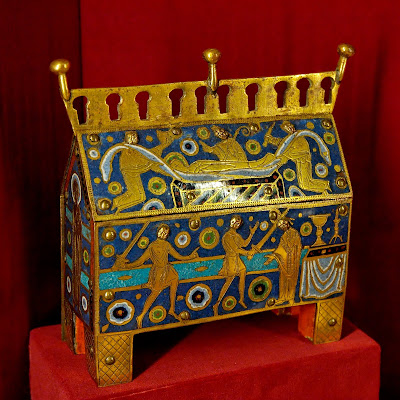Crossposted from Dafydd's Random Music.
"Riddles Wisely Expounded" is the first ballad in Francis Child's
collection
. In it a knight comes wooing three sisters. The youngest sister (who in some of the versions, sleeps with the knight first), is chosen by the knight to answer a series of riddles. If she answers the riddles correctly, then she will wed the knight. In some of the versions collected by Child, the questioner is not a knight, but the Devil disgused as an "unco knicht". When the daughter names him in answer to the last riddle, he shrieks and disappears, and thus the maiden escapes. Until that moment, however, she did not appear to know that she was competing for her soul.
Like many English songs, this ballad has also been collected in America, where it is usually know as "The Devil's Nine Questions." In it, the wooing aspect is dropped and if the maiden (who has often lost her sisters in these versions) fails to answer the riddles, she will be taken to Hell. What binds the two versions together is the set of riddles and their answers. Although there is some variation in the riddles, all of the versions include many of the same riddles. Some of the typical riddles are:
What is longer than the way? (love)
What is deeper than the sea? (hell)
What is higher that the tree? (heaven)
What is louder than the horn? (thunder)
What is sharper than a thorn? (hunger, or death)
What is whiter than milk? (snow)
What is softer than silk? (down)
What is greener that the grass? (poison)
What is worse than woman? (the devil)
Interestingly enough, the American version may be the older version. A mid-15th century version called "Inter diabolus et virgo" (Between the devil and the virgin), was included by Child in his later editions. It bears more resemblance to the American version, being a straightforward confrontation without the wooing setting.
This ballad was one of those that became part of the mid-cetury folk revival, being recorded by Ewan MacColl, Jean Ritchie and others. As such it has had a fairly wide circulation. The following is a listing of every recorded version I could find. I make no guarantees that I have found them all. I also expect this list to fall quickly out of date as there have been seven recordings released in the last five years alone. I welcome any corrections or information about recordings I may have missed.
"Riddles Wisely Expounded"
Daniel Dutton on
Murder of Crows, ?
Ewan MacColl and Peggy Seeger on
The Long Harvest
, Vol. 2, Argo, 1966
Jacqueline and Bridie on
Hold Back the Dawn
, Fontana, 1964
Jean Redpath on
Lowlands
, Philo, 1994
Lon Loomes on
Fearful Symmetry
, Fellside Recordings, 2005
"A Riddle Wisely Expounded"
Hanita Blair on
Minstrel
, Millefolia, 2005
"A Noble Riddle Wisely Expounded"
Askew Sisters on
All In a Garden Green
, Wild Goose Records 2007
Demon Barbers on
Waxed
, Demon Barbers Sounds, 2010
"The Devil's Nine Questions"
Atwater-Donnelly on
The Weaver's Bonny
, Rabbit Island Music, 2009
Bonnie Kolac on
After All This Time, Ovation Records, 1971 (out of print)
Bruce Molsky on
Song Links 2, Fellside Recordings, 2005
Elizabeth Laprelle on
Rain and Snow
, Old 97 Wrecords, 2007
Ewan MacColl and Peggy Seeger on
The Long Harvest, Vol. 2
, Argo, 1966
Ewan MacColl and Peggy Seeger on
Two Way Trip
, Folkways, 1961
Jean Ritchie and Oscar Brand on
Shivaree! - A Folk Wedding Party
, Essential Media Group, 2008
Jill Trinka on
The Little Black Bull, Gia, 2007
Stephen Moore on
Sourwood Mountain: American Folk Traditions, Vol 1
, Stephen Moore, 2005
Texas Gladden on
Ballad Legacy
, Rounder, 2001
"The Devil's Ten Questions"
Phil Cooper on
Written in Our Eyes
, CDBY, 2007
"The Devil's Question"
The Golden Glows on
A Folksongbook, Glans and Luister, 2007
Jean Ritchie and Paul Clayton on
American Folk Tales and Songs
, Tradition Records, 1956.
Here's The Askew Sisters performing "A Noble Riddle Wisely Expounded" live.






















